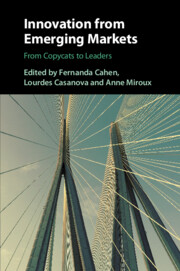Book contents
- Innovation from Emerging Markets
- Innovation from Emerging Markets
- Copyright page
- Contents
- Figures
- Tables
- Boxes
- Contributors
- Foreword
- Acknowledgments
- Introduction
- 1 A Framework for Innovation in Emerging Markets
- Part I Drivers of Innovation in Emerging Markets
- Part II Types of Innovation in Emerging Markets
- 7 The Political Economy of China’s R&D Internationalization
- 8 Emerging Pharmaceutical Companies from China, India, and Brazil
- 9 Reverse Innovation and the Role of Local Partners in Emerging Markets
- 10 Innovation Based on Value Co-creation through Employees at HCL Technologies
- 11 Frugal Innovation in Brazilian Multinationals
- 12 Innovation in War and Peace
- Part III Innovation Outcomes in Emerging Markets
- Conclusions
- Index
- References
11 - Frugal Innovation in Brazilian Multinationals
from Part II - Types of Innovation in Emerging Markets
Published online by Cambridge University Press: 15 March 2021
- Innovation from Emerging Markets
- Innovation from Emerging Markets
- Copyright page
- Contents
- Figures
- Tables
- Boxes
- Contributors
- Foreword
- Acknowledgments
- Introduction
- 1 A Framework for Innovation in Emerging Markets
- Part I Drivers of Innovation in Emerging Markets
- Part II Types of Innovation in Emerging Markets
- 7 The Political Economy of China’s R&D Internationalization
- 8 Emerging Pharmaceutical Companies from China, India, and Brazil
- 9 Reverse Innovation and the Role of Local Partners in Emerging Markets
- 10 Innovation Based on Value Co-creation through Employees at HCL Technologies
- 11 Frugal Innovation in Brazilian Multinationals
- 12 Innovation in War and Peace
- Part III Innovation Outcomes in Emerging Markets
- Conclusions
- Index
- References
Summary
This chapter sheds light on the growing relevance of frugal innovation as EMNCs leverage competitive advantages through its means. We highlight the three component parts (open, sustainable and cost innovation) of this process. Drawing on case studies and a survey of Brazilian MNCs, we demonstrate the stakes of frugal innovation as a catch-up strategy.
Keywords
- Type
- Chapter
- Information
- Innovation from Emerging MarketsFrom Copycats to Leaders, pp. 300 - 324Publisher: Cambridge University PressPrint publication year: 2021



